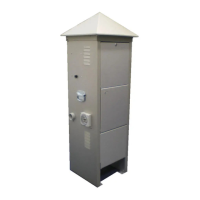Calibration HiVol 3000 User Manual 1.7
54
If during calibration the ambient temperature and pressure are outside the
range of the chart, the following formula may be used to calculate the pressure
drop across the orifice plate for any flow-rate within the range of the sampler:
a
aDISPLAY
T
P
c
Q
H ×
⎟
⎠
⎞
⎜
⎝
⎛
=Δ
2
Equation 1 Drop in pressure
where
ΔH = the difference in the level of water in the two
manometer tubes (mm of H2O)
Q
DISPLAY
= the volumetric flow-rate reading on the air
sampler digital display (m
3
/hour)
P
a
= the ambient pressure (in kPa)
T
a
= the ambient temperature (in degrees Kelvin)
c = orifice constant given on Calibration Chart (for
the particular orifice plate being used)
Eg. If the ambient temperature is 20°C (293K), ambient pressure is 100.8 kPa,
and the orifice plate constant is 3.158, then the equation becomes:
a
aDISPLAY
T
P
c
Q
H ×
⎟
⎠
⎞
⎜
⎝
⎛
=Δ
2
First point (60m
3
/hour):
mm
H
124
293
8.100
158.3
60
2
×
⎟
⎠
⎞
⎜
⎝
⎛
=Δ
Second point (70m
3
/hour):
mm
H
169
293
8.100
158.3
70
2
×
⎟
⎠
⎞
⎜
⎝
⎛
=Δ
Third point (80m
3
/hour):
mm
H
221
293
8.100
158.3
80
2
×
⎟
⎠
⎞
⎜
⎝
⎛
=Δ
Note: The chart gives the same results
and saves calculating each point.
The principle of flow rate calibration is that the air sampler displays a flow-
rate, then the user adjusts the motor speed until the manometer reads the
corresponding pressure drop (from the chart). The user then allows time for
the signal to stabilise, then “locks-in” the point. This procedure is repeated at
three flow rates – 60, 70, 80m
3
/hour. The HiVol then automatically fits a
mathematical curve to the three points and the flow rate calibration is
complete.
The HiVol 3000 uses three-point flow rate calibration, at 60, 70 and
80m
3
/hour. Points 50 and 90 can be checked (but not adjusted) after

